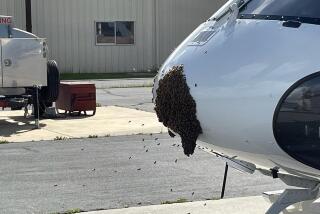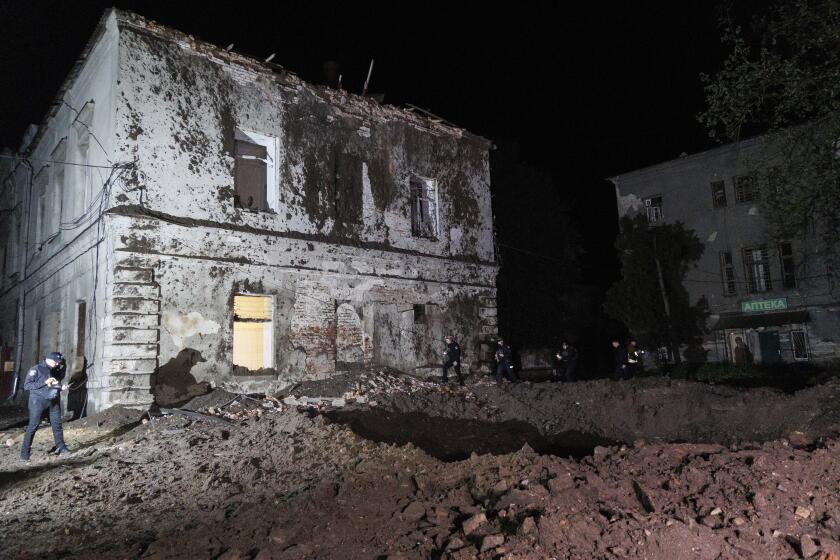War-torn Colombian valley now produces butterflies
Not long ago, Olga Lucia Salazar was breaking chicken necks and plucking feathers under scalding water for a living. Now, at double her former wage, the single mother of three raises gorgeous blue butterflies.
“All I had to look forward to was miserable arthritis and permanently swollen hands,” Salazar said as she arranged about 60 pistachio-sized chrysalises in a cotton-lined white cardboard box. “I can do this at home taking care of my kids. And I work for myself. There is no one screaming orders at me.”
Over the last decade, butterfly exporter Alas de Colombia has given disadvantaged women here steady incomes and converted the iconography of this once war-torn valley from AK-47s and combat fatigues to fluttery symbols of peace and hope.
Based in nearby Cali, Alas de Colombia is owned by the mother-daughter team of Patricia and Vanessa Restrepo, who saw an opening in a growing market for butterflies at weddings and nature exhibits.
“When we started, we knew nothing about entomology and the life cycle of butterflies,” said Patricia, 56, who spent 25 years practicing corporate law before co-founding Alas de Colombia with her daughter. “It took us three years to research their mating habits, what sorts of plants they like to eat and how and where they lay their eggs.”
(For the record, she called the butterflies’ mating ritual an “aerial ballet,” with the male fluttering around the female “until she permits him to couple in a union lasting 15 minutes or more. The two do an aerial pas de deux, often with one of the mates beating his or her wings to keep the couple aloft.”)
After a slow start in 2001, the company keeps 25 women busy as suppliers and ships up to 8,000 butterfly chrysalises a month, mainly to live butterfly exhibits in the United States. Customers include the San Diego Zoo, the Texas Discovery Gardens in Dallas, and the Chicago Academy of Sciences’ Peggy Notebaert Nature Museum. It’s the only Colombian firm licensed to export the insects.
Once in the chrysalis stage, the bugs take 10 to 20 days to emerge from their cocoons, a window the Restrepos use to air-freight their products to their far-flung destinations in time for their emergence as butterflies.
Doug Taron, a curator at Notebaert, said Alas de Colombia is one of the museum’s most valued suppliers in Latin America, not least because the big-winged, blue Morpho peleides, the company’s top-selling bug, is “drop-dead gorgeous.”
“A high percentage of chrysalises they send us, well over 80%, emerge as beautiful, healthy adult butterflies,” Taron said. Live butterfly exhibits are increasingly popular, he said, because “they are non-threatening insects with a complex and interesting life cycle, and they are great hooks to get people interested in science and nature.”
The nice thing about Colombian butterflies such as the blue morpho is that they flutter gently and “behave well,” never dive-bombing visitors as do more aggressive bugs in the insect universe, said Michael Weissmann, an entomologist in Northglenn, Colo., who is a consultant for a Denver butterfly broker.
“They feed on flowers or fruit nearby, and don’t smash against the glass all the time as if trying to get out. Blue morphos are active fliers with stunning colors,” Weissmann said, adding that Alas, which means “wings,” has a reputation for providing “more bug for the buck.”
The company sells thousands of live butterflies a month in Colombia, where Morpho peleides is a national peace symbol and its release at weddings, birthdays and other celebrations is a colorful gesture of best wishes for the future. (The company releases 5% of the butterflies it raises.)
Although the company seems to run like clockwork, Vanessa Restrepo, 30, said there were times she wondered whether she made the right decision turning down lucrative job offers after college to go into the insect business.
“Yes, it would be nice to make a big salary like many of my classmates in university, but working with these beautiful creatures, improving Colombia’s image abroad and having some social impact makes up for it,” she said. “Working with my mother has been just a bonus, a gift.”
The idea for the business grew from a senior thesis that Vanessa wrote at Cali’s Javeriana University, an assignment to invent a unique business. She had just been to an amusement park in central Florida with a live butterfly exhibit, and based her thesis on a hypothetical company that would supply insects to such exhibits. Her mother filled her in on the red tape and permits she’d need to get an export business off the ground.
“This sort of business didn’t exist in Colombia before we came along. My mother and I had to invent it,” Vanessa said. “There was a lot of trial and error, and we had to convince many people in the government. We had the good fortune to be pioneers, and we brought our dream to earth.”
The company is one of 75 Colombian small businesses that receive “bio-commerce” grants from a World Bank- and U.S.-financed fund that supports companies that create green, sustainable products and demonstrate a social conscience.
The loan money that Alas received was divvied up among the women who serve as suppliers. Salazar used her $300 portion to build a 10-foot-square enclosure with clear plastic sheeting where she breeds her butterflies at the Restrepos’ property, a former family getaway on a hillside in Colombia’s Cauca Valley.
After the females lay their eggs — “they look like little water drops,” Salazar says — she takes them home, and nurses the bugs along during their metamorphosis from egg to caterpillar to chrysalis before selling them to Alas for about $1 apiece. (For competitive reasons, Alas declined to say how much the company charges its U.S. clients per chrysalis.)
This valley had a different vibe a few years ago. Just above the “factory” is a hilltop cemetery called El Arenillo where 250 victims of the country’s four-decade civil war are buried in unmarked graves, a reminder of the region’s violent past and tenuous present.
The clear plastic enclosures where butterflies mate and lay eggs are astride a once-strategic corridor that was fought over by leftist guerrillas and paramilitaries.
“People here lived in terror of the parracos until six or seven years ago,” Patricia Restrepo said, using a slang term for paramilitaries. “Since then it’s been quiet because of the tough policies of [former President Alvaro] Uribe.”
Under a demobilization agreement pushed by Uribe, most of the right-wing militia members laid down their arms, though many have gone into drug trafficking and extortion rackets. Thirty miles south, leftist rebels still battle government troops.
In more violent times, poor women had few alternatives to working in the local poultry plant. Armed groups had scared away farmers, as well as wealthy Cali families with weekend retreats who employed women from the valley as domestics.
Joana Martinez, the single mother of a 9-year-old girl, slaughtered chickens at the plant before she turned to raising butterflies for Alas. Since then, she’s been able to buy land and build her own home.
“Instead of killing things all day, I’m raising living things that fly,” she said. “I can’t imagine a better job.”
Kraul is a special correspondent.
More to Read
Start your day right
Sign up for Essential California for news, features and recommendations from the L.A. Times and beyond in your inbox six days a week.
You may occasionally receive promotional content from the Los Angeles Times.






